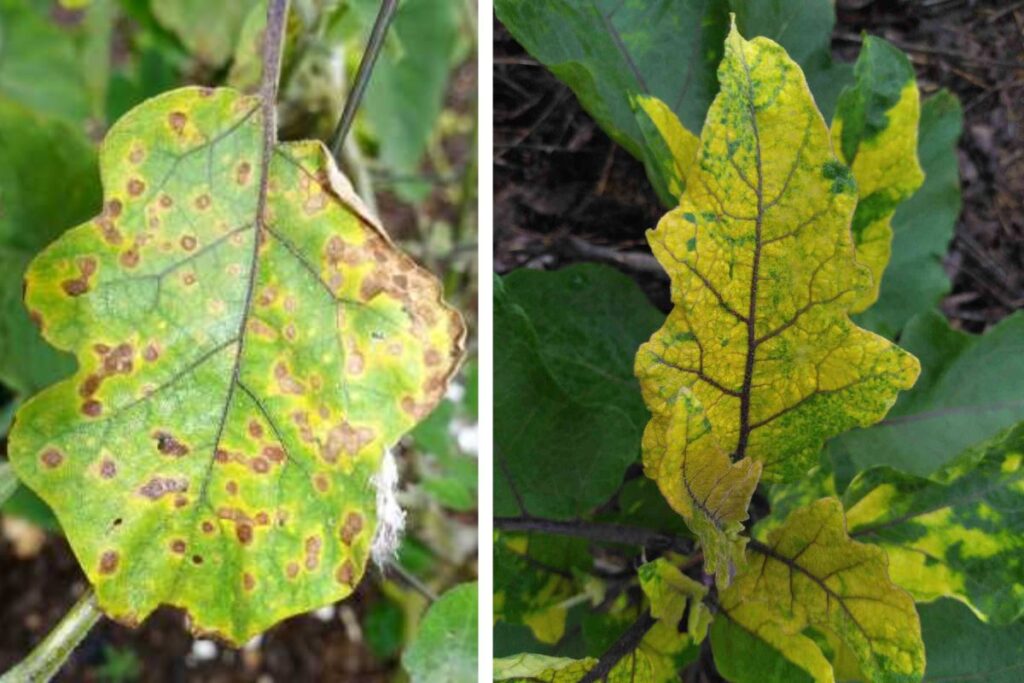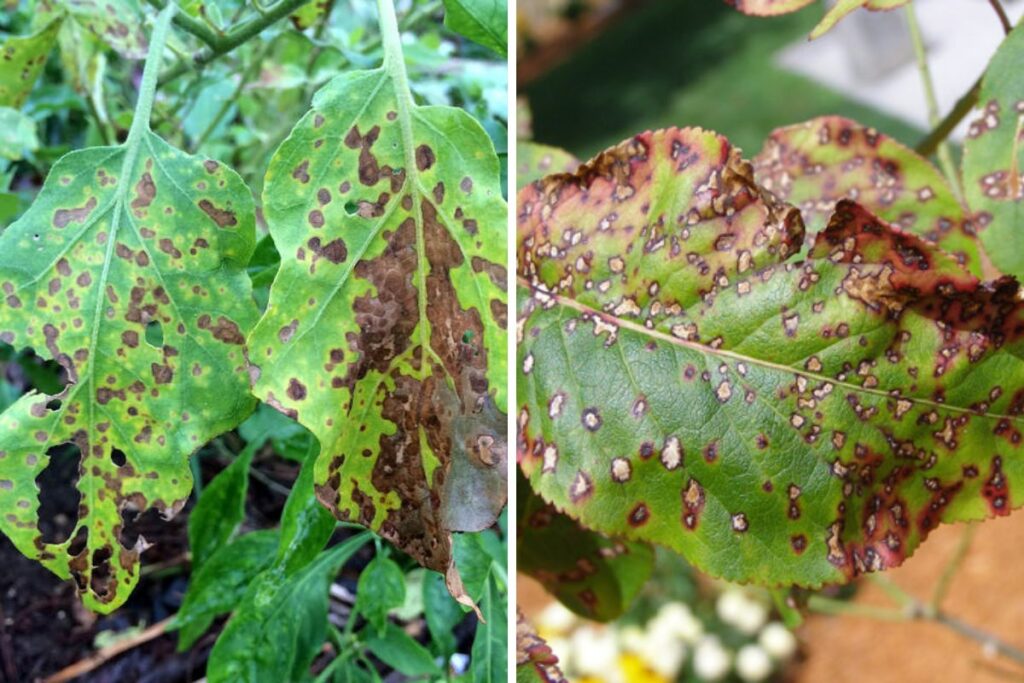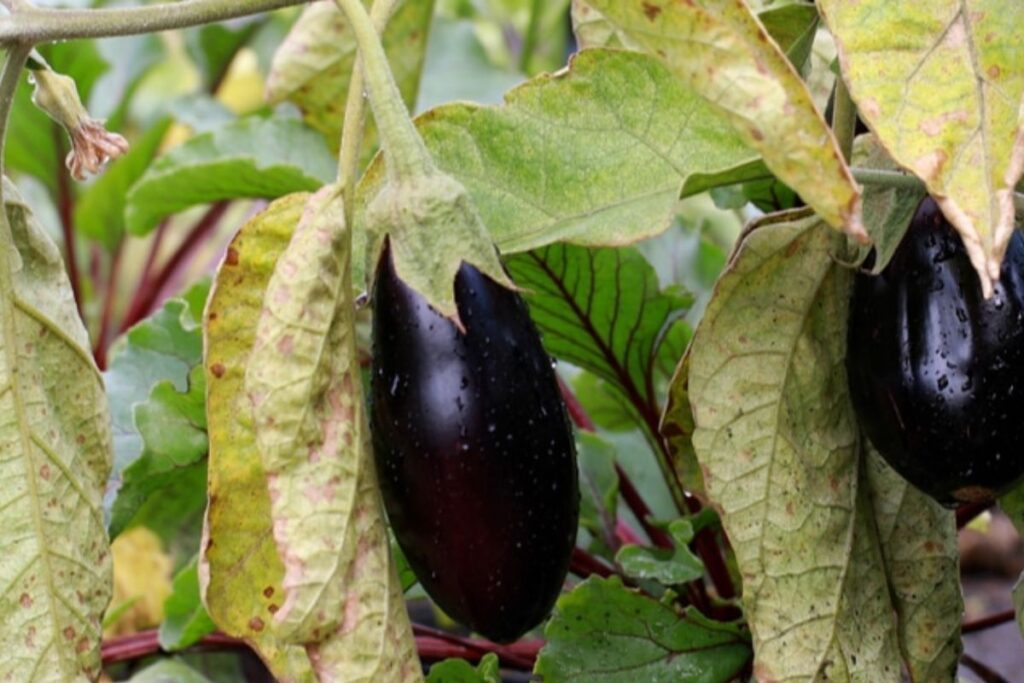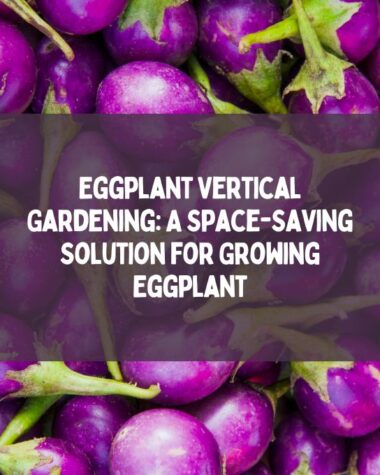Eggplants are a popular vegetable known for their glossy purple skin and versatile culinary uses. However, seeing yellow spots on eggplant leaves can be a cause for concern among gardeners and enthusiasts. In this article, we will explore the reasons behind the yellowing of eggplant leaves and provide practical solutions to address the issue.
Let’s dive in!
What are Yellow Spots on Eggplant Leaves?
Yellow spots on eggplant leaves refer to the appearance of discolored patches or marks on the foliage. These spots can vary in size, shape, and intensity, ranging from light yellow to brown or black.

While it’s normal for older leaves to turn yellow and eventually wither, the presence of yellow spots on young or healthy leaves may indicate an underlying problem.
Related Reading:
- Little Finger Eggplant: Growing Tips, Care, and Recipes
- Do Eggplants Prefer Sun or Shade? An Overview
- Guide On Eggplant Life Cycle: From Seed Germination To Harvesting And Storing
- Top 5 Eggplant Growing Problems (and How to Fix Them)
Why Are My Eggplant Leaves Turning Yellow? 7 Solid Reasons and How to Fix Them
If you’ve noticed that your eggplant leaves are turning yellow, it’s essential to identify the underlying causes and take appropriate action to remedy the situation. There are several possible reasons for this discoloration, ranging from nutrient deficiencies to pest infestations.

In this section of our article about yellow spots on eggplant leaves, we will explore seven common factors that can lead to yellowing eggplant leaves and provide effective solutions to address each issue.
Here are 7 solid reasons of eggplant yellow spots and their solutions.
1. Bacterial or Fungal Leaf Spot Infections
Bacterial and fungal infections are common culprits behind yellow spots on eggplant leaves. Bacterial leaf spots, caused by bacteria like Xanthomonas campestris, often manifest as small, water-soaked spots that enlarge and turn yellow over time.
On the other hand, pathogens like Alternaria spp. or Septoria spp. cause fungal leaf spots, which are characterized by irregular or circular yellow spots with dark centers.
Solution
To address these infections, remove and destroy the infected leaves, ensuring proper sanitation practices. Applying copper-based fungicides can also help control bacterial and fungal leaf spot diseases. Remember to follow the instructions on the fungicide label for optimal results.
2. Nutrient Deficiencies
Yellow spots on eggplant leaves can also indicate nutrient deficiencies, notably nitrogen, magnesium, or potassium. Nitrogen deficiency often causes the lower leaves to turn yellow first, while magnesium deficiency leads to yellowing between the veins, leaving green veins behind.
Potassium deficiency, on the other hand, manifests as yellow spots or marginal necrosis on the leaves.
Solution
To address nutrient deficiencies, you can apply balanced fertilizers or organic amendments that are rich in the deficient nutrients. For nitrogen deficiency, use a fertilizer with a higher nitrogen content.
Epsom salt (magnesium sulfate) can be used to correct magnesium deficiency, and potassium-rich fertilizers can help combat potassium deficiency. Always follow the recommended application rates and schedules to avoid over-fertilization.
3. Pest Infestations
Certain pests, such as spider mites or aphids, can cause yellow spots on eggplant leaves. These tiny insects feed on the sap of the leaves, leading to chlorosis and the appearance of yellow patches. Additionally, their feeding can weaken the plants, making them more susceptible to other issues.
Solution
To control pest infestations, consider using insecticidal soaps or horticultural oils specifically formulated for these pests. Natural predators, like ladybugs or lacewings, can also help keep pest populations in check. Regularly inspect your plants and take action at the first sign of infestation.
4. Watering Issues
Improper watering practices can contribute to yellow spots on eggplant leaves. Overwatering can lead to root rot, inhibiting the plant’s ability to absorb nutrients and causing the leaves to turn yellow.
On the other hand, underwatering can result in water stress and nutrient imbalances, leading to similar symptoms.
Solution
To ensure proper eggplant watering, allow the soil to dry out slightly between waterings, and provide adequate drainage to prevent waterlogging. Regularly monitor the moisture levels in the soil by sticking your finger into the top inch of soil.
If it feels dry at that depth, it’s time to water. Adjust your watering routine based on the specific needs of your eggplant plants and the prevailing weather conditions.
5. Environmental Stress
Yellow spots on eggplant leaves can also be a response to environmental stress factors. Excessive heat, cold temperatures, strong winds, or sudden temperature fluctuations can all contribute to leaf yellowing and damage.
Additionally, prolonged exposure to direct sunlight without adequate shade can lead to sunburn, resulting in yellow spots.
Solution
To mitigate environmental stress, provide appropriate protection to your eggplant plants. Shield them from extreme temperatures or frost by covering them with protective structures or using row covers.
Implement shade cloth or natural shading techniques to limit direct sunlight exposure. Creating a microclimate that suits the eggplant’s preferences can help reduce stress and promote healthy growth.
6. Soil pH Imbalance
Eggplants thrive in slightly acidic to neutral soil conditions. When the soil pH is too high or too low, nutrient availability can be compromised, leading to yellow spots on the leaves. Alkaline soil conditions (pH above 7) can cause nutrient deficiencies, particularly for iron, resulting in interveinal chlorosis and yellowing.
Solution
To address pH imbalances, test your soil’s pH level using a soil testing kit or by sending a sample to a local agricultural extension office.
If the pH is too high, consider amending the soil with elemental sulfur or organic materials like compost or peat moss to lower the pH gradually. Conversely, if the pH is too low, add agricultural lime to raise it to the appropriate range.
7. Viral Infections
Viral infections can also be responsible for yellow spots on eggplant leaves. Unfortunately, there are no specific treatments for viral infections, and affected plants should be removed and destroyed to prevent the spread of the virus.
It’s crucial to practice good sanitation measures, such as regularly disinfecting tools and avoiding the use of infected plant materials as compost.
By understanding these causes and implementing the necessary remedies, you can restore the health and vibrancy of your eggplant plants.
Related Reading:
- Discovering the Majesty of Tropical Plants: A Guide to Growing Tropical Plants and Care
- 10 Tomato Diseases – How to Recognize, Treat, and Prevent?
- Cucumber Leaf Curl: Causes and Solutions for Healthy Plants
- Diseases of Pumpkin Plants: Identification, Treatment, and Prevention Strategies
- 5 Reasons Why Zucchini Leaves Turn Brown
- Troubleshooting Carrot Growing Problems: Why Won’t My Carrots Develop?
How do you tell the difference between a bacterial and a fungal leaf spot?

Differentiating between bacterial and fungal leaf spot infections requires a simple tissue test. Gently wipe the yellow spots with a clean tissue or cotton swab. If the tissue turns yellowish-brown or reddish, it suggests a bacterial infection. However, if the tissue shows dark spores or a powdery residue, a fungal infection is likely the cause.
Should I remove leaves that are turning yellow?
Removing leaves that are turning yellow can help mitigate the spread of diseases and pests. If the yellowing is limited to a few leaves, you can carefully prune them off and dispose of them properly. Be sure to sanitize your pruning tools between cuts to prevent cross-contamination. However, if the majority of the plant’s leaves are turning yellow, it may indicate a more severe problem, and addressing the underlying cause is essential.
Why are my eggplant leaves curling after yellow spots?

Eggplant leaves curling after yellow spots can be a sign of severe stress or damage to the plant. This could be due to factors such as pest infestations, diseases, nutrient deficiencies, or adverse environmental conditions. By addressing the root cause, providing proper care, and implementing appropriate treatments, you can help restore the health and vigor of your eggplant plants.
Conclusion
Yellow spots on eggplant leaves can indicate underlying issues that require attention and care. By understanding the potential causes and implementing appropriate solutions, you can help ensure the health and productivity of your eggplant plants.
Remember to address bacterial or fungal infections, manage nutrient deficiencies, control pests, provide proper watering and environmental conditions, and maintain optimal soil pH. With these proactive measures, you’ll be on your way to vibrant and thriving eggplant plants in no time!
FAQs
Here are some faqs about aubergine yellow leaves.
Does calcium deficiency cause yellow leaves?
Calcium deficiency can contribute to the development of yellow leaves in plants. It often leads to a condition known as blossom end rot, where the bottoms of fruits, such as eggplants, turn black or brown. While calcium deficiency itself may not cause yellow spots on the leaves, it can weaken the plant and make it more susceptible to other issues that result in leaf yellowing.
What nutrient is needed for yellow leaves?
Yellow leaves can be an indication of various nutrient deficiencies. Nitrogen, magnesium, and potassium are commonly associated with yellowing symptoms. Nitrogen deficiency leads to overall yellowing of the plant; magnesium deficiency causes interveinal chlorosis; and potassium deficiency may result in yellow spots or marginal necrosis on the leaves.
What deficiency causes yellow spots on leaves?
There are a number of deficiencies that can result in yellow spots on leaves, including nitrogen, magnesium, or potassium. Each deficiency manifests in distinct patterns and symptoms. Nitrogen deficiency typically results in overall yellowing, while magnesium deficiency leads to interveinal chlorosis. Potassium deficiency can cause yellow spots or marginal necrosis on the leaves.







